|
TERRIFIC RESPONSE FOR SURPLUS PROPERTY
When, through the medium of The War Warmed Over column, the Roundup announced that plans are being made to sell surplus Army property to I-B Theater G.I.'s, more than a ripple of interest was expected. But the Roundup hardly anticipated it would give impetus to such a tremendous tidal wave of response. Letters, Letters, Letters. Questions, Questions, Questions. So many that it is unfortunately impossible to answer them personally. First of all, there's one point we wish to make absolutely clear: THE SALE OF SURPLUS PROPERTY TO G.I.'S IS NOT YET AN ACCOMPLISHED FACT. As War Warmed Over stated, plans are only in the formative stage. The Liquidation Commission, the column reported, will not be set up for at least a month. Your letters were invited for two reasons: (1) To ascertain your interest; (2) Through your questions, to bring to light thorny problems to solve before the plan is placed in operation. It has been explained to us that present plans are for every G.I. to have first priority on the equipment personally used by him. Then second priority on property used by his unit. And, finally, on equipment used by other organizations not purchased by its members. The proposal now under consideration is for the equipment to be shipped free to the U.S., the G.I. paying transportation only from the port to the place he designates it be delivered. Payment for the property will most probably not be asked until receipt at home, for the equipment would be subject to import duty, export license and several heavy taxes in India unless shipped out of India as Army property. Public Law 457 requires equipment must be purchased only for personal use or for setting up your own business. It may not be purchased for resale, either in India or in the U.S. Only probable limitation on the amount of property purchasable will be the size of your pocketbook. No sales will be made until units are broken up, which will be determined, naturally, by the course of the war. As envisioned now, prices will be fixed by the Liquidation Commission, with a sliding scale of discount for condition of the property. You can see that there are many problems that must be worked out. It will take time and patience. The Roundup will continue to keep you informed. |

Vol. III No. 39 Delhi, Thursday, May 31, 1945 Reg. No. L5015
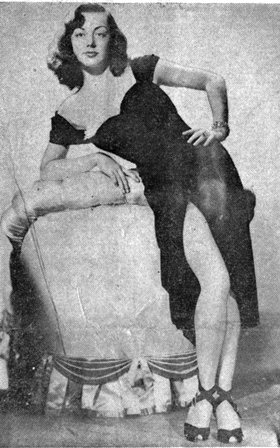 It hardly seems possible, but the staid Sporting News, Baseball's Bible, sent the Roundup the
above tantalizing picture of provocative Anne Shirley. We didn't object. Natcherly.
It hardly seems possible, but the staid Sporting News, Baseball's Bible, sent the Roundup the
above tantalizing picture of provocative Anne Shirley. We didn't object. Natcherly.
|
This week the full meaning that prophecy has been brought home to the Japanese people.
Thursday, 550 B-29's, comprising the largest force yet to strike the Jap homeland, dropped 9,000,000 pounds of fire bombs on Tokyo's Shinagawa industrial area, smashing waterfront installations, railroad yards and aircraft parts factories south of the Imperial Palace. Flames from the burning city were visible for 200 miles.
500-PLANE STRIKE
Saturday, less than 48 hours after that devastating fir raid, 500 Forts thundered over Tokyo's Marunouchi business district and Imperial government center, dropping more than 4,000 tons of fire bombs.
Sunday, the voice of Radio Tokyo spoke from the ruins of what once was the world's third largest city. Quoting Premier Suzuki, the broadcaster said: "Tokyo has been destroyed beyond hope of repair. Two palaces have been destroyed. Metropolitan Tokyo is literally scorched to the ground. What is left of the capital is still smoldering."
EIGHTH A.F. TO PACIFIC
As Radio Tokyo spoke of Japan's leveled cities and American losses on the last two raids were assessed at 31 planes, plans for even heavier aerial blows on the Jap "heartland" were well on the way toward realization. The assignment of Lt. Gen. James H. Doolittle to the Pacific suggested that B-17's and B-24's would soon join the Super-Forts.
Elsewhere in the Pacific, the Japs resorted more and more to suicide Kamikaze Corps air attacks and banzai charges. But the results, while inflicting local damage and casualties, were comparable to the assault of a sand flea on the tough hide of an elephant: Irritating but not serious.
On Okinawa the tide of battle was slow and costly. By Monday, following a breakthrough by the Seventh Infantry Division in the Japs' line of cliff fortifications on the east coast of the island below Yonabaru, the enemy appeared to be withdrawing from Shuri Fortress in the center of the battle line after a fierce 38-day defense.
For weary Marines and infantrymen, though, the going was tough. The Weather man had given them new headaches all week as torrential rains turned the earth into quagmire, flooded rivers and washed away three of the four bridges Marines had thrown across Sato River into the capital city of Naha. Despite the weather, however, troops of the Seventh dug Japs out of positions in steep coastal cliffs after intense hand-to-hand and grenade warfare and pushed on across flooded rice paddies to the edge of the village of Chan, two miles south of Shuri. Marines, fighting behind tanks, drove to within 800 yards of Naha Harbor.
North of Shuri, the Marine First Division reported Japs were blowing up food and other supplies.
In a series of raids in Okinawa waters, 11 light units of the Pacific Fleet were damaged by Jap banzai air attacks. One Jap bomber landed on American-held Yontan airfield on Okinawa and disgorged a handful of suicide assault troops who managed to set fire to a number of American planes before they were killed.
Fighting on Mindanao Island in the Southern Philippines was officially termed in the "mopping up" stage Friday, but thousands of Jap troops remain to be dug out of mountain positions. On Luzon, flame-throwing tanks were used for the first time in the successful storming of a formidable mountain ridge in the Manila watershed which had held out for three weeks. Disintegrating Jap forces encircled northeast of Manila were reported showing for the first time disposition to surrender. Jap civilians who evacuated Davao on Mindanao were reported being inducted into the Jap Army.
In Manila, General Douglas MacArthur released casualty figures for the Philippines campaign; 378,000 Japs killed, 8,000 during the last week. American casualties, 50,000 killed, wounded and missing.
On the little-known battlefronts of the Pacific, sporadic warfare was reported against isolated Jap pockets on North Borneo' Tarakan Island, around Wewak, British New Guinea and along Buin Trail on South Bouganville.
|
By Sgt. JOHN McDOWELL Roundup Staff Writer
Lowell Thomas, graying, globe-trotting NBC news commentator and author of numerous travel books, paused in Delhi this week on his way to the Pacific Theater of Operations long enough to observe that, to him, "time has stood still in India."
Lounging in the lobby of the Hotel Imperial, Thomas voiced his outspoken admiration of a comely Indian lass in a clinging pink sari whose peregrinations were visibly disturbing to every male in the vicinity, and then remarked in a mood of reminiscence, "I lived in India for two years after the last war. And, when I got up this morning and looked out of the window on Queensway, I saw the same bullock carts, the same tongas, the same styles I learned to know so well back in 1920. Then it occurred to me that time makes no changes in India's way of life.
Although he would not commit himself on specific details of his immediate plans, Thomas disclosed he is en route to the Pacific where he is to make a tour of the far-flung battle fronts of that Theater with Lt. Gen. James H. Doolittle.
After covering the American 104th Division in action in Germany, Thomas talked himself into a ride in a P-51 fighter plane over Berlin, which was being liquidated by the Red Army at that time. "In the past," Thomas said, "passengers had made short flights in a P-51. But I believe I was the first person to make an extended flight as a passenger in that single-seat fighter."
The only space available for a passenger in a P-51 is a small battery storage compartment behind the pilot's seat in the cockpit. "Two men lifted me and jammed me into this narrow slot with my legs protruding straight in the air," Thomas recalled. "Then they packed a wire recorder in beside me. For more than three hours I flew over German lines and circled over Berlin, recording the flight, feeling all the time like a double-jointed pretzel."
Because of a low overcast, the plane maintained a ceiling varying between 3,000 and 6,000 feet, Thomas said. This allowed excellent observation of activities on the ground. And absence of flak and fighter opposition generated a feeling of sitting high in the press box of a stadium broadcasting a football game.
"Berlin was a chaos of smoke and flame, polka-dotted with puff balls of artillery hits and beribboned with streaks of tracer fire," Thomas said. "Parts of the sprawling metropolis - apparently sections already overrun by the Red Army - were smoldering, cataclysmic desolation of crumbled masonry and twisted girders. Roads leading from the city were streams of humanity - Germans moving toward the American lines like endless chains of ants."
Thomas is no stranger to war. For two decades after World War I he covered for press and radio mankind's uprisings and revolts around the world. And, he had his share of action in the last war, including service with Lawrence in Arabia. But, he admitted he had never seen brutality and human depravity on such a cold-blooded, wholesale scale as at the Nazi concentration camp of Buchenwald.
"I entered Buchenwald with American forces which captured that largest of the Nazi concentration camps," he said. "Believe me, all accounts of Nazi torture and bestiality which you are now reading in newspapers and magazines are, if anything, understatements. For the whole story of the Nazi horror camps can never be printed."
The German people, Thomas believes, had no idea of what was going on behind the high walls of the concentration camps, "for the things that went on in those camps cannot be conceived or imagined in the minds of normal persons, be they German or American or any other civilized people."
Thomas returned to the States before starting his trip to the Pacific. He arrived in New York City on the afternoon of V-E Day and, despite the litter of confetti on the streets "the people seemed to take the news of victory calmly. Perhaps," he concluded, "V-E Day came as an anti-climax after many false rumors of victory, but I think too there was an underlying realization by the home front that there will be no end to casualty lists and sobering telegrams until Japan has been defeated. There was a feeling that celebration while men were dying on Okinawa, in the Philippines, over Japan, was indecent."
|
IN CHINESE ADVANCE
Roundup Staff Article
Chinese troops have retaken the important port of Nanning, former American 14th Air Force fighter base and a vital link in the Japanese overland highway lifeline to Indo-China and Singapore. The treaty port of 68,000 persons in Kwangsi Province sits astride the enemy north-south highway.
A later report said that the Chinese troops had reached the vicinity of Pingyiang, 60 miles northeast of Nanning and almost a third of the way to the former big American bases at Kweilin.
Claiming still further successes on the east coast of China, Chungking announced the taking of Loyuan, 35 miles north of the captured port of Foochow.
A Chinese communiqu also reported the capture of Mamoy, eight miles southeast of Foochow. Foochow, which had a population of almost 400,000 before the war, is directly across the Taiwan Strait, 130 miles from Northern Formosa.
Earlier it was announced by Chungking that Chinese troops, advancing down the Kweichow-Kwansi Railway, had captured Hwaiyuanchen, 50 miles northwest of Luichow, which is 125 miles northeast of Nanning. Later Chinese forces were reported as being 43 miles from Liuchow.
Chinese forces were reported to have routed Jap troops 19 miles west of Paoching, strong enemy base in Hunan Province.
ATC MEN GENEROUS
1330 AAF BU, ATC - Highlighting a farewell ceremony given by Indian students of a Christian mission high school near this base, Air Transport Command personnel from Assam and Burma this week donated $150.00 in War Bonds to Dr. J. W. Cook and Miss E. Victoria Christensen, Assam missionaries who are returning to the United States on leave.
At the same time, a cash gift was given to Bendang Wati, an Indian teacher in the mission school who is to accompany the missionaries to the United States, where he will attend a theological seminary.
During the past three years, Dr. Cook has entertained soldiers in his home, which has been open at all times to men on furlough or pass.
Each Sunday evening an average of 50 soldiers have attended services at the mission church and remained for dinner afterward in the Cook bungalow.
‘Co-Prosperity Sphere’ Failure By HUGH A. CRUMPLER United Press Correspondent
RANGOON - Burma under the "Greater East Asia Co-Prosperity Sphere" was remarkably unprosperous.
During the 38 months of Japanese occupation, the country's internal transportation system collapsed. Rice wasted in South Burma, while the people of Central and North Burma were on starvation diets because the railways were wrecked and the highways and rivers were under constant bombing and strafing attacks by Allied aircraft.
Burma, world's biggest rice-exporting country, found herself without a market. Allied naval strength made Rangoon and other harbors useless. No sea-going cargo ship has been in Rangoon harbor for more than a year and a half.
The country's economy collapsed under the double burden of losing both internal and external markets for its chief product. The old Burmese currency went "underground" and the Japanese printing press money took a sharp dive in value. Inflation and the black market invaded the country's bazaars.
PLANTS INOPERATIVE
Burma imports practically all the manufactured goods consumed in the country. Her few factories were kept out of operation by air attacks.
The effect of being cut off from the market for manufactured goods is apparent at any gathering of Burmese people. Burma's national costume is the brightly-colored lungyi, but the Burmese today are dressed in drab, mended clothes. Many are wearing altered Japanese uniforms.
To make matters worse, the Japanese commandeered much machinery and civilian goods shortly after they occupied Burma. Refrigerators, radios, silverware, china and other European goods were shipped to Japan.
The Japanese butchered a large number of livestock, for which the peasants were paid in invasion money. Preliminary estimates place the census of water buffalo, oxen and cattle at about 70 percent of the pre-war total.
LOOTING
Looting, much of which was apparently without reason, practically cleaned Rangoon of valuables.
Accounts and records of insurance companies, banks and other financial concerns were torn up and burned or strewn in the streets. The British had flown a lock-picking expert from London to open the bank vaults but when he arrived they had all been blasted.
Much road and railway reconstruction must be carried out before Burma's agricultural economy can return to normal. Railway engines, wagons and repair materials must be shipped into the country. Fleets of river boats, the country's chief method of internal transportation, were decimated by air attacks and must be replaced.
Rangoon harbor will probably be devoted exclusively to military supplies for at least the next six months. After that the tremendous job of reconstruction will begin, at first under British Civil Affairs branch of the Army, later under a new Government of Burma.
|
Hundreds of supply-laden trucks roaring up the dense, jungled sides of the Patkai Range on their way to China pass a scattered group of buildings known as the Tagap Hospital. Situated on the side of a 4,500-foot peak, it is the only hospital is Asia entirely staffed by Negroes and is one of two such colored units overseas today.
It was to this site of deserted warehouses, bashas and mess halls, left abandoned as the Stilwell Road progressed steadily forward, that the all-Negro Station Hospital moved in October, 1944, to serve the thousands of troops who perform maintenance and improvements on the highway and drive the big cargo vehicles over the important supply route deep into Burma and China. Since 65 percent of the personnel on the Stilwell Road are colored, it is only fitting that one of the Negro Hospitals be chosen to carry on its work here.
But the patients treated are of a wide variety. "We have somewhat of an international aspect," one technician remarked. Chinese, British, Indians, Burmese, as well as Americans, both white and colored, are cared for as the occasion demands. About 20 percent of the patients to date have been white.
The first job that confronted the medics upon their arrival at Tagap was the need for improved facilities to shelter and treat the sick and wounded. With the help of native labor, new bamboo bashas were constructed
|
Salvaged pipe was obtained from Pipeline Engineers and a complete water system was installed running from watersheds high in the surrounding hills. The colored medical technicians and hospital men improvised ways to provide hot water, electrical and auxiliary power sources.
The entire area was re-worked to provide better drainage. Deep ditches were dug to carry off the tons of water that rush down the precipitous mountain sides. Some of the old buildings were burned and their bamboo sides salvaged and moved to new locations.
High winds tore up the movie amphitheater and a new one was 'dozed from sloping hillsides. A ball diamond and basketball courts are kept in perfect condition, for sports are an important part of the morale program, since the troops, isolated as they are, have no access to recreational centers.
The site of the hospital has an interesting history. It was for centuries the happy hunting grounds of the Nagas, a primitive people who, only a generation or two ago, were headhunters and even today display the skulls of hapless adversaries as trophies in their native bamboo bustees.
When the Japs captured Rangoon early in 1942 and swept northward through the Mogaung and Hukawng Valley, they were slowed down as they reached the forbidding eternally dim jungles of the Tagap region - farthest point of penetration in their bid to overrun all of northern Burma. Setting up entrenchments and fortification, they dug in against the fury of the monsoon that swept down from the heavy, low-hanging clouds that move in like a storm from sea.
American-trained Chinese Armies late in 1943 marched from Ledo over the Stilwell Road Lifeline and engaged the Japs in a short skirmish. Deserted by their frightened elephant wallahs and unable to stem the Chinese drive, the Japs fled toward prepared positions to the south and Tagap became a Chinese-American depot.
The hospital that has grown out of the sweat and planning of the doctors, nurses, medical technicians, cooks, mechanics and other soldiers is a thoroughly modern institution, a tremendous tribute to the ingenuity and perseverance of the courageous men and women who administer to the sick and wounded at their hospital in the clouds.
Personnel performing the many functions required are from two separate units. Commanding officer of the entire unit is tall, alert Maj. William H. Strickland, graduate of Lincoln University and the Howard Institute of
|
Assisting him is a capable and well known surgeon, Maj. Robert S. Wilkinson, whose contributions to outstanding surgical journals are quoted in Military Surgical Manuals. He was a former associate visiting surgeon for the Harlem Hospital, New York City, and consulting surgeon for the Harlem Valley State Hospital. Wilkinson, pleasant and efficient, was a Phi Beta kappa at Dartmouth College before entering Harvard Medical College.
Aside from his duties as surgical head of the Tagap unit, Wilkinson is also commanding officer of a complete station hospital unit which is attached here while awaiting orders to move to another location and install a medical center there.
The two units work together, each contributing to a continuous training program that is opening up the fields of X-Ray, Pharmacy, Clinical laboratory work, Operating Room procedure and ward duty to more men all the time.
Activated in August, 1943, the unit commanded by Strickland worked together in the States one year before departing for the India-Burma Theater. As one of the original staff of the first all-Negro Hospitals at Fort Huschuca, Ariz., he was assistant chief of medicine there when called upon to activate and command the new unit destined for overseas service. A cadre from Strickland's organization later helped found the second unit commanded by Wilkinson.
In the first three and one-half months of operation, more than 500 patients were treated at the Tagap institution. Thirty miles from the hospital at a particularly dangerous spot on the Stilwell Road, where construction and pipeline engineers work, an ambulance and first aid station has been set up to provide protection for the soldiers thus endangered.
Though deep in the Burma jungle, the hospital is equipped and prepared for any contingency. Ample stores of medical and surgical supplies are kept on hand. An X-Ray section, Pharmacy, Laboratory, Operating Rooms and Dental Clinic are staffed by able doctors, nurses, and technicians.
In charge of the Pharmacy, Sgt. John R. King, former Roxbury, Mass., pharmacist, has supervised the filling of 1,800 prescriptions since the hospital opened its doors for business prior to the first of January, 1945. In addition to meeting all requirements of the patients, adjoining outfits are also supplied. Clean, glistening and professional, the Pharmacy is more complete and has better facilities for the producing of prescriptions than the average corner drug store in your hometown.
A visit to the operating section is a revelation. Busy, efficient Negro nurses in the central dressing room adjacent fold and sterilize bandages and supplies. Pleasant, smiling principal chief nurse, Lt. Agnes B. Glass, Meridian, Miss., explained, "An operation is like a stage play. Just as rehearsals and stage settings take more time than the actual play runs, so does each operation require endless hours of preparing bandages, syringes, sterile gloves, cotton dressings, tubes, needles, and novocaines."
In the Clinical Laboratory, trained soldier technicians perform such tests as urinalysis, hematology, feces, sputum, malaria and other smears, averaging 1,000 separate lab checks monthly.
A trip through the wards reveals both colored and white patients recuperating from diverse ailments. Outstanding among convalescents was Cpl. Grady Neal, 37-year-old Flagstaff, Ariz. soldier who has spent more than three months recovering from serious injuries sustained along the Stilwell Road.
Neal, a QM truck driver, while carrying supplies forward plummeted 350 feet over a sheer cliff when his heavily-laden cargo carrier slid in the slick mud, careened from the side of the bank and headed for the yawning abyss below. "I never knew what happened until I woke up here," Neal asserted. Despite a fractured leg, six broken ribs, dislocation and concussion, he is mending nicely under the careful eye of the Negro Hospital personnel.
In a medical ward, S/Sgt. Gordon A. Vangsness, a white soldier from Villa park, Ill., a pipeline construction foreman was attacked by two of the most prevalent diseases of this Theater - amoebic and bacillary dysentery, but is due to leave the hospital shortly after receiving every attention there.
Nurse Lt. Daryle E. Foister, Bedford, Penn., is typical of the girls caring for the hospitalized soldiers, and is experiencing her second assignment overseas. Miss Foister spent 10 months in Liberia during the early days of the war. "I haven't minded my overseas duty," she remarked. "I've learned a lot about the customs and habits of foreign peoples." Trained at Mercy Hospital, Philadelphia, she later was connected with the Sea View Hospital, Staten Island, N.Y.
Efficiency among the personnel has not been confined solely to those directly concerned with treating the patients, however. Cpl. Albert Cox, Chicago, was dissatisfied with the regular army stoves for baking purposes. Cox, an experienced baker in civilian life designed and supervised the construction of a large brick oven which turns out pies, cakes, and pastries without peer in this jungle-bound section of the world.
The G.I.'s are looking forward to their future in America and have taken up the voluntary savings plans offered by the Army. The pay allotment of the organization for savings and war bonds exceeds 75 percent of their total wages. A large percentage of the group have enrolled in the many courses offered by the Armed Forces Institute.
Maj. Strickland, proud of the complete facilities his unit offers, remarked that the Dental Clinic compared favorably with those in the States and added jocularly, "Our magazines are even twice as old as those in dentist's offices back home."
Head of the Clinic is Capt. George E. Marshall, Jamaica, L.I., who, assisted by two enlisted men dental technicians, keeps an amazing number of teeth in biting order. Marshall performs dental surgery, impactions, and ordinary
|
In the ward area, some harmony drifted from a bamboo basha not unlike those around it. This was the Red Cross Club, managed by Negro Hospital worker Bernice Grice, Omaha, Neb., who brings cheer and helps the white and colored recuperants while away dull hours. Impish and congenial, Miss Grice, a graduate of the University of Omaha, and with a Master of Arts degree from Howard University, finds the job a pleasant challenge to help the men forget sickness and prepare them for soldiering duties.
"They're all babies," she commented, "Always teasing me." Bernice Grice provides special attention to neurotic cases, usually giving them something constructive to do with their hands.
The Tagap Hospital is a model Army institution, but Dr. Strickland, its commanding officer, summed up the spirit of the task his Negro comrades face treating the men of the Stilwell Road, who brave injury and death as they rush war supplies to our Chinese allies. "We are not an unusual organization," Strickland modestly asserted, "We are well-trained American citizens who happen to be colored. We are ready and able to do anything that comes within the scope of that training."
"To the majority of our personnel, the inauguration of this hospital represents the fulfillment of an ideal; an ideal that allows free men the opportunity to pursue their chosen professions, regardless of race or creed. We are proud to have been chosen to serve our country in the capacities for which our training and talents best fit us."
|
PERFORMED ON BURMA MOUNTAIN BY FLASHLIGHT
10TH A.F. HQ., BURMA - Sgt. John Klepey, Cooperstown, N.Y., medic from a 10th Air Force signal air warning crew, owes his life to a doctor, a dentist, a radio technician, and strangely enough, a pile of beer cases.
Klepey picked an unfortunate spot to have a ruptured appendix - on top of a Burma mountain with 50 miles of dense jungle between himself and the nearest hospital. As a medical technician, he was able to diagnose his own case and immediately wired the signal battalion dispensary at 10th Air Force headquarters.
At 5:30 a.m., Capt. Benjamin Leavitt, battalion surgeon from Fall River, Mass., read the radiogram.
"Have the patient evacuated immediately," he ordered.
In a few minutes, a radio came back. "Can't. Patient too ill to be moved."
There was no alternative but to go in after Klepey and operate. But the only surgical technician with the crew was Klepey himself, there was no anesthetist, no operating table. So thick was the jungle that even the "Jungle Angels," flying L-5's which the 10th uses for air evacuation, could not land.
So Leavitt, and Capt. Anson H. Sollner, battalion dentist, from Arma, Kans., acting as "surgical technician," set out to cover the 50 miles in a jeep, traveling over twisting jungle roads, across swift mountain streams, with Leavitt clutching his precious instruments.
Reaching the base of the mountain, they hired three Burmese guides and bearers to carry their equipment to the top. It took them three hours to go 50 miles by jeep, but it took five precious hours to struggle the last few miles to the mountain top and reach their patient.
Klepey was in bad shape; early peritonitis and gangrene complicated his case. Without wasting a moment, Leavitt and the signal crew built what was a strange operating table. Beer cases dropped only a day before formed the base, which was reinforced by bamboo poles and covered with canvas and blanket.
As Leavitt administered a spinal anesthetic and made his incision, the last rays of the setting sun faded below the mountain top. Flashlights were called into action. Pvt. Joseph Paskowski, of Chicago, Ill., taking pictures of the operations, focused on the incision in the abdomen, then quietly fainted. T/Sgt. Charles J. Loth, Newark, N.J., radio technician, stepped in and administered ether.
The operation took 45 minutes. Klepey was ill for two days, but six days later the stitches were removed. He could sit up on the seventh day. Exactly nine days after the operation, he was climbing around the mountain, again able to administer necessary first aid to the members of the crew who had assisted in his own operation.
QUESTIONNAIRES UNCOVER G.I. HUMORISTS IN ASC GROUP
ASSAM - All G.I.'s by now are familiar with the questionnaire forms Public Relations Officers throughout the Army require soldiers to fill out for them. Ready information is needed about the men within each command so that news stories may be written by PRO's, the lazy cusses, without their having to scratch too vigorously for facts.
These questionnaires afford G.I.'s every opportunity to give vent to their fertile imaginations; so the yeasty PRO of Col. C. N. Braswell's Global Planesmen ASC I-B T Group, went through his files and extracted choice examples of humor both premeditated and unrehearsed.
It should be borne in mind, however, that the questions, in general, satisfactorily perform their mission - that it's with the exceptions that the chuckles occur.
Under "Civilian Occupation?" one G.I. wrote, "Self-unemployed."
Under "Born?" another comedian inscribed (naturally), "Yes."
Still another informed all and sundry, "I had a run-in with my draft board - so I was drafted."
Again for "Civilian Occupation?" an answer was "None in particular."
To the query "Wife's Maiden Name?" one said, "Single - but very hopeful."
For "Sports Excelled In?" a sharp G.I. quipped "Poker specialist, ping-pong champ and pool shark."
Plenty of elbow room for gags was allowed in the "Under this section please list anything that has happened to you both in and out of the Army that be of news interest" department, check these answers: "In the Army too long," "There's no place like home," "What a life without a wife - she's so beautiful and so far away." Another remonstrated, "Busybody."
General impressions and percentages gathered from this statistical hunt of Global Planesmen PRO files elicits the following information:
1 - Everybody in the Army does not come from Texas or Brooklyn - quite a large percentage are actually from the United States.
2 - Fifty-five percent of the G.I.'s are married, five percent divorced.
3 - Ninety-eight and 6/7 percent consider themselves excellent in at least two sports.
4 - The impression is erroneous that all Air Corps men are sergeants or better - 26 percent are not.
5 - Thirty-three percent did not work before entering the Army, and about half of the others forget who were their civilian employers.
What did they do in civilian life? A medical technician was an apprentice funeral director and embalmer. An enlisted surgical specialist was a wrapping machine operator in a bakery. A G.I. "who used to bowl for a living" now drives a truck, as does (and is it significant?) a former wrecking specialist. Finally, a former speculator operates the local salvage dump, and, one wonders, at a profit?
|
Roundup Staff Article
Army Air Force beacon lights transformed the world-famous Taj Mahal Gardens at Agra into an American fairground during V-E weekend.
Using two beacon lights and emergency field units, G.I.'s of the Air Service Command Depot squeezed the mammoth lights through the Taj's gates soon after official announcement of Victory in Europe.
A crowd of curious Indians gathered around Capt. D. W. Atkinson, Depot Maintenance Officer, who supervised the job, wondering what the "crazy Imreecans" were doing now. When the floodlights were turned on that evening, they quickly malumed.
For the first time in history, the exquisite symmetry of the Tak glistened in breathtaking white splendor under artificial light.
WONDER OF WORLD
Constructed in the 16th century by the fabulous Emperor Shah Hehan, the Taj is considered one of the wonders of the world. Shah Jehan erected the shrine by the labors of his many peoples in memory of his lovely wife entombed there along the banks of the Jumna River.
An Indian rajah who came to view the floodlighting took one long look, according Sgt. Paul Brundza, in charge of one of the units, and said, "The Japs won't last three months." He then strolled majestically away, surrounded by his body guard.
"It's no wonder he was impressed," declared Brundza. "We used approximately 4,000,000 candlepower to get the effect we wanted; and that's enough to open anyone's eyes."
'GAVE US MERRY TIME'
Of the visiting Indians, Cpl. Robert McLaren remarked, "They gave us a merry time. First, they'd try to re-focus the lights to suit their own tastes; then they'd try to chisel our drinking water."
"How about those guys who would stand there and stare straight into the floodlight," said Brundza wonderingly. "Even when I worked at the New York World's Fair I never saw anything like that."
The project for floodlighting the historic Taj was prompted by Slipstream, Agra Base newspaper, which headlined an article about the relighting of the Statue of Liberty in the following manner: "Hint for the Taj."
R. H. Soloway, District Commander at Agra, read the story and contacted American authorities who facilitated the installation through Lt. Col. Henry R. Lyon, Base Executive Officer.
|
By SGT. CHARLES CLARK Roundup Staff Writer
The war in Burma is becoming more personal every day for S/Sgt. Claude Lacy, L-5 liaison pilot for the 1st Air Commandos. Short time ago, Lacy dived his small plane, Lacy's Lassie, at a detachment of Jap infantry and drove them into the hands of the British 14th Army. This done, he headed for home, only to be met by ground fire from a well-camouflaged enemy machine gun. Next morning Lacy went back to the machine gun nest and wiped it out with a shower of grenades attached to gasoline-filled whiskey bottles. The Japs promptly detailed a one-man patrol to Lacy's home base to eliminate this "honorable annoyance." The Nip scored a direct hit under the plane's cowling. As soon as his plane is repaired, Lacy swears he'll even the score.
Quick thinking of Cpl. Louis R. Paternoster recently saved an RAF cargo plane from a crackup on an attempted night landing at an unlighted Arakan airfield. paternoster, member of the Combat Cargo Task Force, was standing guard when he heard the plane coming in on the approach, only to veer off before touching down. Paternoster quickly drove a jeep to the end of the runway, focused the headlights straight down the strip, and then ducked as the plane skimmed over his head to a safe landing. Paternoster was rewarded with some of the best British brandy and rum, apparently on the plane for just such emergencies.
Word has just reached us (via square-wheeled bullock cart) of the amazing energy and devotion of Capt. Edwin H. Kimbrough, chaplain of the 2nd Air Commando Group. To attend to both the spiritual and personal needs of his "boys" in out-of-the-way places, Chaplain Kimbrough flies more than 8,000 miles each month, about 60 hours passenger time. On Easter Sunday alone he traveled 625 miles to visit five air bases. To Kimbrough, a toast! - in lemon squash, of course.
And the tears flowed like sake. After driving the Stilwell Highway to China, Pfc. Lawrence Larson purchased a quart of Chinese liquor to take back to his thirsty buddies in Assam. Carefully he wrapped and packed the cargo to prevent breaking and then headed for home. Back at APO 487, Larson hurried to his tent and his comrades, yelled "Surprise!" - and then dropped the bottle!
"Having been thoroughly scorned by the women of our choosing, and since we highly resolve never to try to understand women in general," members of an Assam Signal Company have united in their misery and have established the Bachelors of War society, an off-shoot of the Brush-Off Club. Included in the by-laws of these jilted G.I.'s are (a) No member is expected to act like a gentleman; and (b) excessive drinking is encouraged. Charter members: Francis Demitrio, Cleveland Seward, Joseph DePrimio, Jesse Smith, William Lowry, Robert Langland, Sherman Rollnick, John Centa, William Oliphant, Richard Bickford, and Frank Waters.
Sgt. Peter Trudell, his tour of duty finished and "eligible to return home" (loud guffaws), will not have far to go to reach the family hearth. Member of a Quartermaster unit in Calcutta, he was born in that charming Bengal metropolis of American parents, but "like any G.I." he's anxious to go Statesward to visit relatives.
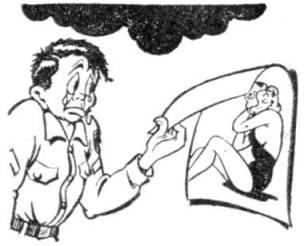 QUICK - A TOWEL FOR MISS DIX
QUICK - A TOWEL FOR MISS DIX
Soldier, tear that tantalizing, sultry pinup girl off your wall if you have any regard for your future happiness!
Such was the warning voiced this week by the New York Mirror's advice to the lovelorn expert, Dorothy Dix, who conjured up a disturbing picture of hundreds of thousands of returning Servicemen pining away in self-inflicted celibacy, dreaming of some will-of-the-wisp pinup girl while flesh-and-blood girls faced lonely spinsterhood.
"Pinups will menace Servicemen's future happiness," Miss Dix sobbed, "because having spent months
|
Hope for the wives and sweethearts back home was voiced in the philosophy of a Naga chieftain, however. When contacted by a Roundup correspondent this week, the Naga head man, a long-time collector of American pinup pictures, pointed to his collection of shapely beauties which adorn the bamboo walls of his hut and then waved a fond hand at his giggling, tattooed wives. "Bird in hand worth two in bush," he said.
|
DOOLITTLE VISITS STRAT 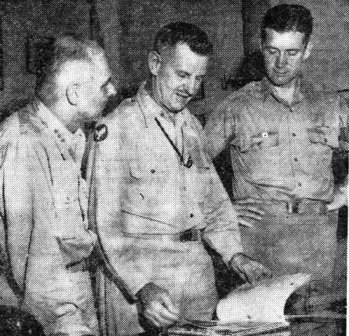 En route to the Pacific, where his 8th Air Force is being redeployed, Lt. Gen. James H. Doolittle, left,
visited EAC-AAF Headquarters near Calcutta. Maj. Gen. George E. Stratemeyer, center, showed Doolittle and Maj.
Gen. Earle E. Patridge, right, photographs of damaged wreaked during recent attacks on Jap installations in
Burma. Patridge is Commanding General of the 3rd Air Division, 8th Air Force.
En route to the Pacific, where his 8th Air Force is being redeployed, Lt. Gen. James H. Doolittle, left,
visited EAC-AAF Headquarters near Calcutta. Maj. Gen. George E. Stratemeyer, center, showed Doolittle and Maj.
Gen. Earle E. Patridge, right, photographs of damaged wreaked during recent attacks on Jap installations in
Burma. Patridge is Commanding General of the 3rd Air Division, 8th Air Force.
|
14TH RAKES JAPS
14TH A.F. HQ. - Dreaded Mustang and Thunderbolt fighters of Maj. Gen. C. L. Chennault's 14th
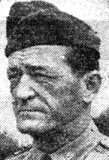
|
Entrenched Japs at Huluehchen on the Yellow River sector were hard hit, and one Mustang mission sowed death among Nip soldiers caught sunbathing at Siangtan. More than 600 Japs were claimed as killed on May 24 alone.
The ceaseless offensive against the enemy's Yellow River rail supply continued as 78 locomotives were damaged in widespread strikes. Fighters and mediums destroyed 16 spans of the Lung hai bridge at Chungmow.
Mustangs supporting advancing Chinese troops near Paoching sent smoke rising 7,000 feet as they burned out 50 buildings containing gasoline. No air opposition was encountered during the week, but eight grounded Nip planes were damaged in sweeps of Jap-held fields at Sinsiang, Shihkiachwang and Hsuchang.
|
LEES FLY TOGETHER
FOR 14,000 MILES AROUND WORLD
EAC HQ. - When Lt. Stanley G. Y. Lee met Lt. Kin Foo Lee at Columbia Army Base, Columbia, S.C., early in 1944, a "combat partnership" was formed which has brought the two 23-year-old Chinese-American airmen 14,000 miles around the world together.
Now pilot and bombardier-navigator of one of the USAAF 12th Bomb Group's "Earthquaker" B-25's, the two Lees have totaled 98 missions and 420 combat hours over enemy territory, including a medium altitude bombing and low-level strafing attack on Rangoon shortly before that vital Burma seaport was occupied by the 14th Army.
This was the longest mission carried out by the "Earthquakers" since they came to India.
Lee, the pilot, and Lee, the bombardier-navigator, both enlisted for cadet training in 1943, Stanley Lee serving at the Dodge City, Kans., air base and Kin Foo Lee training at Luke Field, Ariz., before meeting at Columbia where they received overseas combat training. Both Lees hold the Air Medal and two combat stars.
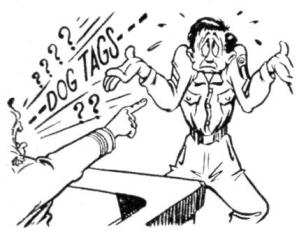
Story With A Moral
ASC BASE, ASSAM - Men, there's a moral to this story: Keep a tight rein on your dog tags.
Because one G.I. didn't. Maj. Studart Scott of New York, head baboo of an air service squadron here, recently received a letter from Tampa, Fla., police, charging Sgt. Carl Lokken of Ulen, Minn., with robbery.
The letter explained a burglary had been committed and that Lokken's dog tags had been found at the scene of the pilfering. As the robbery occurred last Christmas, and the sergeant was here, the major couldn't see how he could have been there.
So the major answered and explained the improbability of his pulling a steal 12,000 miles from the scene of the crime. Lokken has been overseas for a year.
25,000 TROOPS, 1,500 PACK ANIMALS MOVED OVER HUMP
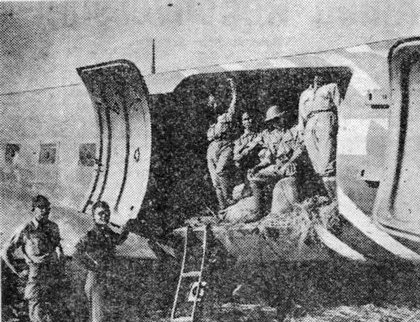
|
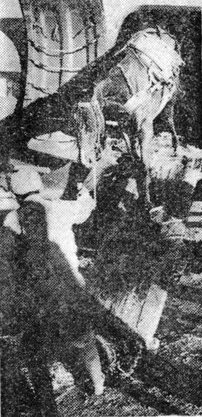
|
EAC HQ. - Jap ground troops were driving west from Liuchow early last December, seriously threatening Chungking and Kunming, as well as the air and land route between India and China.
To counter this threat, it was decided to transport by air from North Burma to China the 14th and 22nd Divisions of the Chinese Sixth Army, together with their pack animals and equipment.
The aircraft assigned to the lift were Combat cargo and Troop Carrier units of the 10th Air Force, EAC; two C-47 squadrons of the 1st and 2nd Air Commando Groups, EAC; and transport aircraft of the India-China Division of the ATC.
Early in December, the 14th Division was moved. The 22nd was transferred at the end of the month and during the first part of January.
JEEPS, HOWITZERS INCLUDED IN CARGO
More than 25,000 troops and 1,500 pack animals were transported.
Miscellaneous cargo included scores of jeeps, howitzers, mortars.
Altogether, more than 1,300 sorties were flown.
Troops were flown from bases in the Myitkyina area to airfields in the vicinity of Kunming.
The entire operation was directed by Col. Sydney D. Grubbs, Jr., Deputy Chief of Staff, 10th Air Force.
It was one of the largest air movements of men and equipment in the history of the India-Burma and China Theaters; it was the first time pack animals were flown across the Hump in such large numbers.
STUBBORN MULES PROTEST LOADING
Four horses or mules were loaded in each plane, with four Chinese to tend them during flight. While the horses entered the aircraft docilely, the mules invariably had to be pushed up the "gangplank" and dragged forward into their bamboo stalls. All the animals made the two and one-half hour trip without incident and behaved well during the unloading in China.
For many of the Chinese soldiers, it was their first flight. Their broad grins and ting haos testified they were enjoying the experience. Most of them were delighted when the terraced farmland of China appeared below them.
Two aircraft were lost on the first day's flight because of weather.
At one forward China base, as many as 50 transports were lined up along the taxi strips at one time during the unloading of troops, animals and equipment.
|
Cuts EAC Activities
EAC HQ. - Early arrival of the monsoon season in Burma has minimized Eastern Air Command operations in that sector.
With all activity cut to a minimum, attacks on enemy troops during the week were carried out in only three areas. Around Mokpalin, where the enemy is standing fast in order to protect the road and rail routes to Moulmein, small formations of U.S. B-25's made several attacks; the same Mitchells hit the Japs at Toungoo, and RAF Mosquitos ranged over the Irrawaddy delta, hitting isolated groups of Nip infantry.
Heavy bombers had one successful day against the Mokpalin-Singapore railway. They destroyed or made unserviceable at least three bridges, hit the approaches to two others, and blew part of a train off the tracks at the terminus of Ye on the branch line south of Moulmein.
It was announced at week's end that nine B-25's of the 12th Bomb Group Battering Ram squadron flew what is believed to be the longest medium bomber mission of the war. The Mitchell's flew through the overcast to the important Jap-held airfield of Ban Takli, 100 miles north of Bangkok, and made direct hits on runways and other airport installations. All the planes returned safely. Col. Lloyd H. Dalton, Group commander, led the assault.
STUBBORN BURMA FIGHTING
NIPS STRIVE TO KEEP OPEN ESCAPE GAPS
Roundup Staff Article
Retreating Japanese forces were fighting with stubborn savagery in Eastern Burma this week in a desperate attempt to keep open their last remaining escape routes over the Shan Hills into Siam.
On the Toungoo-Mawchi road, the British 14th Army, recently reinforced by the veteran 36th Division, met heavy and vicious opposition, with the Japs making full use of the tough jungle terrain. Pitched artillery battles were waged along the winding escape artery.
Farther south, troops of the Fifth Indian Division pushed 14 miles up the Pegu-Toungoo road to capture the village of Mokshitwa. Bitter fighting is in progress two miles west of Kama.
Other British units entered the inland port of Bassein and found it abandoned by the Japanese. Bassein, on the Bassein River, lies 88 miles west of Rangoon.
|
Probably the most powerful enemy of G.I.'s in India-Burma has never fired a shot at them, but there are some little-known outfits which have fired plenty of shots at that enemy.
They have been waging and winning a struggle against dread malaria.
Americans have lived, fought, and worked in India and Burma where the population was infected almost 100 percent, and stringent control measures have reduced the malarial rate to less than one-eighth of figures originally predicted by officials in India.
When troops first arrived in India they were told their job could not be accomplished, not because of Japs, terrain and weather - but because of malaria. These predictions were based on statistics which show that 100,000,000 people in India are afflicted each year and that 1,000,000 of these die.
Americans did not belittle these predictions. At that time, early 1942, they knew malaria, claiming four to six times the casualties of battle, had not been conquered in the Southwest Pacific.
To start, the Army made a lieutenant colonel of an American doctor who had operated his own hospital in Assam. A specialist in tropical medicine, Earl M. Rice, with 20 years experience, was assigned the task of controlling the scourge. This South Carolinian, who earned his M.D. degree at the University of Oregon, knew the heart of the area where malaria had to be whipped because he had lived in it with his specialist's knowledge for so long.
Meanwhile, medical experience on Guadalcanal had created two types of organizations - control and survey units - which were being formed and trained in the United States.
Control units consisted of a sanitary corps officer and 11 enlisted men. Their job was drainage, spraying with oil and Paris Green to kill larvae, mosquito-proofing of quarters and spraying to kill the adult mosquito. Survey units laid the groundwork for control. They evacuated areas and examined blood and spleens of local children to determine incidence. Their personnel consisted of two officers, an etymologist and parasitologist and 11 enlisted men.
SPECIALISTS WORKED OUT AHEAD
Equipped with laboratories, these specialists worked ahead of the control units. When they found enlarged spleens in children up to 12, they knew they were dealing with an infected population. They took blood smears to determine the parasites.
Malarial experts say that a 25 percent spleen rate is bad, but in Assam and Burma the rate consistently exceeded 90 percent and often rose to 100 percent.
Shortly after Rice took over his big job, two each of these units arrived on the India scene. Others arrived later but delays were encountered because of inability to get equipment and supplies from the States. Finally, the War Department gave a shipment priority equal to that of food and ammunition.
Sections of India and Burma presented problems peculiar to their respective areas. In Bengal, the anopheles philippinensis was worst, multiplying in tanks impossible to drain.
Assam was found to be a hyperendemic area, with 50 percent or more of the people stricken. Here was found the anopheles minimus, the most violent mosquito carrier known, breeding in monsoon seepage area. This deathly carrier was found also in the thick vegetation along mountain streams where the Stilwell Road had to be built.
The survey teams pushed along with the builders of the Stilwell Road into the Hukawng Valley, a place which has remained uninhabited because of the prevalence of the anopheles minimus mosquito and its dread runner-up, the anopheles leucosphyrus. They destroyed mosquitoes so other men could build a road and a pipeline - and so others could destroy Japs.
Prevention of breeding was not enough. Sprays, screening, netting were needed. Aerosol bombs - ingenious metal cylinders containing pyrethrum and freon-12 - were devised. These self-sprayers, a flit-gun without a handle and without the need of muscle power, meant instant death for mosquitoes. Contents of one of these bombs, no bigger than a small tin can, equal a gallon of liquid spray. These were ideal in the compactness for field units.
Millions of yards of hessian cloth - made from Indian jute - was used to control the menace. It was used to line bamboo bashas, tents, bombed buildings, anything used as an Army billet.
TROOPS USED LIQUID REPELLENT
Troops on the move often could not take these precautionary measures. They used liquid repellent, dimethyl-phthalate, which was spread on hands, face, ankles, any exposed skin at night. Troops attending open-air movies in mosquito areas had to apply repellent before gaining admission.
To combat malaria, entire villages have been sprayed with liquid insecticide. Late in 1944, the India-Burma Theater began to receive quantities of the new wonder chemical - DDT (dichlorodiphenyltrichloroethane). It is a substance which will retain its killing power for several months after application to a surface. It was possible to use it in villages and areas constituting major menaces. To cover large areas, sometimes it was sprayed by plane.
Military medical authorities believe that atabrine, one of the wonder drugs of the war, did more than any one thing to combat malaria for individuals on the move. Malarialogists in India-Burma declare its value far exceeds that of quinine in fighting malaria.
Atabrine doesn't prevent a person's contracting the benign type of malaria, but will suppress it so that he doesn't suffer from its effect. It usually does prevent malignant malaria.
Malaria hasn't been stamped out in India-Burma, and medical authorities do not expect it to be until control measures are universally adopted. But the rate for American troops has dropped below what in the beginning was never expected.
The fight still goes on under the direction of Col. Karl R. Lundeberg, chief of preventive medicine in India-Burma, Col. Rice having gone to serve as medical adviser to Lord Louis Mountbatten.
Many of us in the Army owe our lives to the constant vigilance of these men and their survey and control units. It is very likely that the Jap might still be astride the life line to China of it weren't for them and their work.
|
For G.I. Dischargees
By Sgt. JOHN McDOWELL Roundup Staff Writer
During recent months, many a sheet of newsprint has been bespattered with advice and opinion on exactly how to deal with the problem of the return of the soldier to the prosaic pursuits of civilian life. And, rightfully, the problem should be considered seriously, for maladjustments such as have occurred in the case of one Frank Garcia, of Houston, Tex., will appear more frequently as more and more men are discharged from the Service.
Garcia, 21, veteran of the North African and Italian campaigns, has found reconversion a gradual affair. This can best be illustrated by the fact that four nights a week he sleeps beneath clean sheets on a soft bed in his home and the remaining three nights are spent in a foxhole in his backyard. Commenting on the soft civilian life - feather beds, feather pillows, fancy food and clean clothes - the twice-wounded ex-sergeant snorts, "Nuts. I can't get used to it."
CIVILIAN 'BASIC'
Perhaps the most constructive idea to appear on the post-war horizon has been advanced by T/Sgt. Daniel Killoran of Hartford, Conn., veteran of Australia, Hollandia and the Philippines who has just been discharged under the new point system. Summing up his attitude toward return to civvies, Killoran said, "They have basic training for us when we go into the Army. I think they ought to have basic training before we become civilians again."
Basic training for new civilians! The idea is revolutionary and as such, the Roundup presents the first tangible plan for "Civilian Replacement Training Centers."
Camp sites for civilian training centers should be selected with care. Preferably, a camp should have an urban air of noise, factory smoke and confusion. If possible, it should be located on a busy thoroughfare, near an elevated and close to a congested industrial area.
REVEILLE
Strigent daily programs must be maintained. The embryonic civilian will be awakened at 6:55 a.m. by the raucous clatter of a battered Big Ben. By 7 a.m. he will be dressed, shaved and, gulping a cup of tepid coffee en route, will sprint madly for the corner streetcar.
Physical fitness must be emphasized if the one-time dogface is to stand up under the stress and strain of everyday life. The trainee will be taken through a daily obstacle course, which will include a 30-minute ride, standing in the aisle of an over-crowded streetcar or bus; a six-block hike through the main shopping center during the "frantic" rush hours; shopping tour through a department store featuring a month-end sale, and a series of "jay-walking" sprints across traffic-snarled highways.
COURTESY
A course in civilian courtesy will be included in the program. Under the tutelage of trained technicians, the trainee will be instructed in such civilian bon mots as "Stay on your own side of the road you (censored)
|
A series of training films will enlighten the returning vets on new everyday practices in the world they are about to enter. These films will deal with a myriad of vital topics such as Shopping on the Black Market, How to Get C Card Gas Mileage Out of Your A Card, A Study in Civilian Complaining, and Ration Board Blues.
As a sub-topic for this series of films, discussions will be held on the point system. Here, the befuddled soldier will be impressed with the fact that points have nothing to do with months in the service, Bronze Star Medals or procreative foresight, but deal solely with such things as canned peas and carrots, lamb chops, shoes and girdles. Here too, the implications of stamps - red, blue, green, striped, cancelled, and predated - will be explained.
BIVOUAC
Orientation will not be forgotten. Lectures and slides and posters will acquaint the trainee with such strange implements of the civilian world as the motor car with steering wheel shift, M-1, elevators and bath tubs. Wearing and care of civilian uniforms also will be studied.
As a final phase of basic training, before being shipped to a port of civilian embarkation, the trainee will go on a one-week bivouac with some civilian family. Here he will put into practice the theories learned during basic training. He will be late for meals, leave dirty clothes lying all over the house, insult the neighbors - in short, he will demonstrate he is ready for the Great Adventure. Civilian Life!
The Roundup is a weekly newspaper of the United States Forces, published by and for the men in Burma and India, from news and pictures supplied by staff members, soldier correspondents, Army News Service and United Press. The Roundup is published Thursday of each week and is printed by The Statesman in New Delhi and Calcutta, India. Editorial matter should be sent directly to Capt. Floyd Walter, Hq., U.S.F., I.B.T., APO 885, New York, N.Y., and should arrive not later than Saturday in order to be included in that week's issue. Pictures must arrive by Friday and must be negatives or enlargements. Stories should contain full name and organization of sender. Complaints about circulation should be sent directly to Lt. Drexel Nixon, Base Section APO 465, New York, N.Y. Units on the mailing list should make notification of any major change in personnel strength or any change of APO.

|
MAY 31, 1945
Original issue of India-Burma Theater Roundup shared by Hal Baker
Copyright © 2009 Carl Warren Weidenburner
TOP OF PAGE PRINT THIS PAGE ABOUT THIS PAGE SEND COMMENTS
PREVIOUS ISSUE CLOSE THIS WINDOW NEXT ISSUE
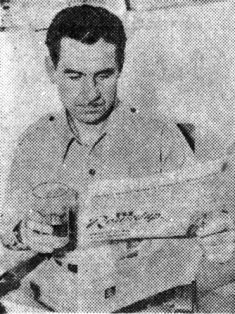 LOWELL THOMAS
LOWELL THOMAS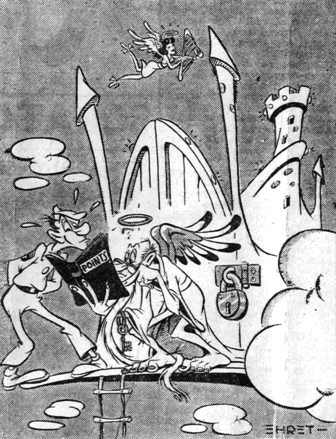 "SORRY, OLD MAN, BUT YOU'RE THREE POINTS SHORT OF THE CRITICAL SCORE."
"SORRY, OLD MAN, BUT YOU'RE THREE POINTS SHORT OF THE CRITICAL SCORE."
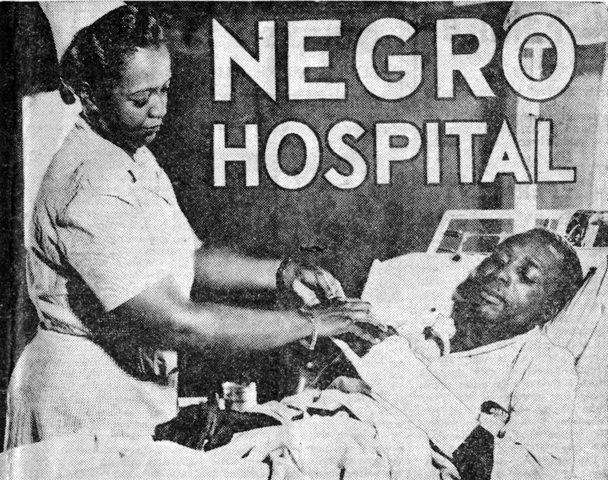 Nurse Lt. R. G. Glover, Dayton, O., inspects the cast on the arm of Cpl. Grady Neal, QM truck driver who
plummeted 350 feet down a precipitous mountainside.
Nurse Lt. R. G. Glover, Dayton, O., inspects the cast on the arm of Cpl. Grady Neal, QM truck driver who
plummeted 350 feet down a precipitous mountainside.
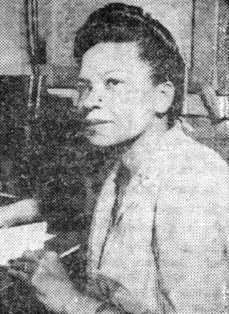 Comely Lt. Agnes B. Glass, Meridian, Miss., is Chief Nurse of the Negro Hospital on the Stilwell Road.
Comely Lt. Agnes B. Glass, Meridian, Miss., is Chief Nurse of the Negro Hospital on the Stilwell Road.
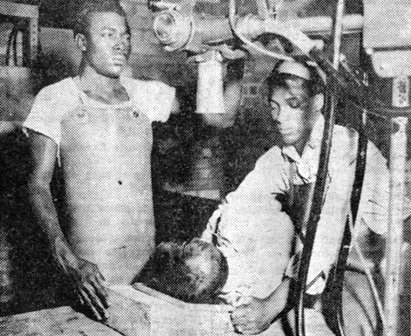 X-Ray Technicians Pfc. Jesse Blakely, left, and Sgt. Calvin Sowell make a picture of an American soldier's head.
X-Ray Technicians Pfc. Jesse Blakely, left, and Sgt. Calvin Sowell make a picture of an American soldier's head.
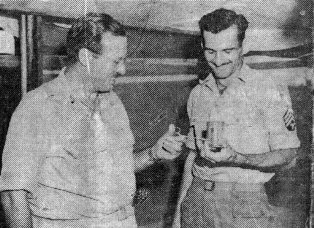 Capt. Benjamin Leavitt points out an appendix to its former owner, Sgt. John Klepey.
Capt. Benjamin Leavitt points out an appendix to its former owner, Sgt. John Klepey.
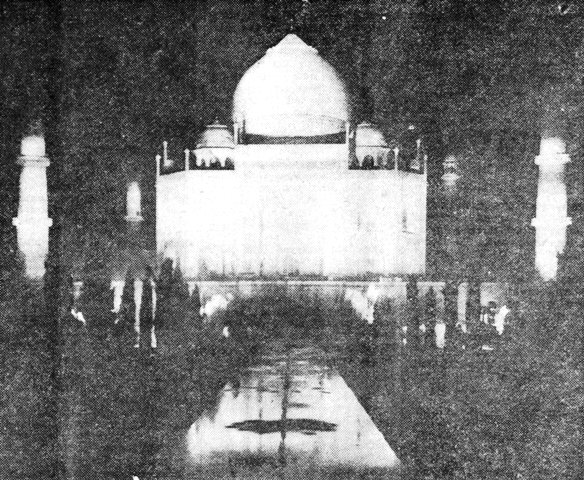
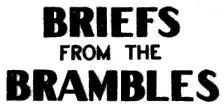
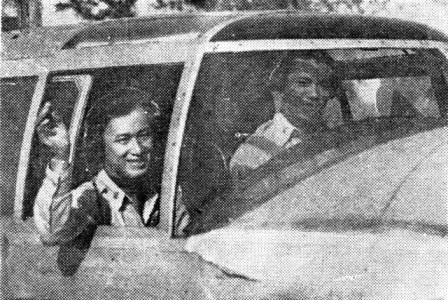 Lts. Kin Foo Lee, left, and Stanley G. Y. lee would seem to be the perfectly matched flying team. Both are
named Lee, both are 23 years old, both are Chinese-Americans. The two 10th A.F. members have been together ever
since they "crewed up" at Columbia, S.C.
Lts. Kin Foo Lee, left, and Stanley G. Y. lee would seem to be the perfectly matched flying team. Both are
named Lee, both are 23 years old, both are Chinese-Americans. The two 10th A.F. members have been together ever
since they "crewed up" at Columbia, S.C.
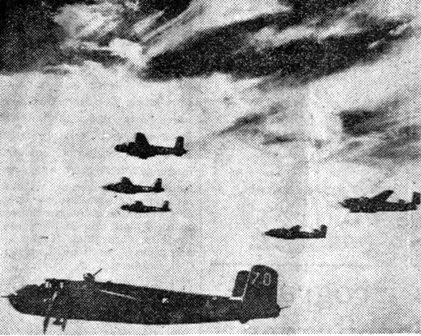 USAAF B-25's of the 12th Bomb Group, EAC, head into the clouds over the Chin Hills on a mission into Burma.
USAAF B-25's of the 12th Bomb Group, EAC, head into the clouds over the Chin Hills on a mission into Burma.

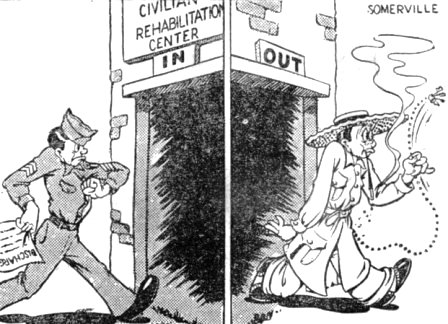
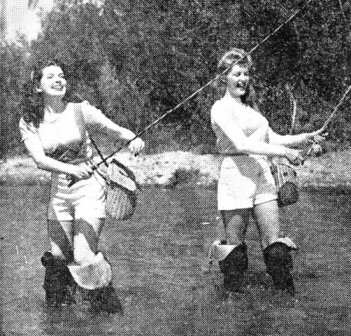 These two Hollywood starlets, names unimportant at this distance, solve their food problems with a bit of angling.
A government survey shows that fishing will be a No. 1 sport of returning servicemen, but doesn't guarantee such
scenery as this when you return to the States and get out your rod and reel.
These two Hollywood starlets, names unimportant at this distance, solve their food problems with a bit of angling.
A government survey shows that fishing will be a No. 1 sport of returning servicemen, but doesn't guarantee such
scenery as this when you return to the States and get out your rod and reel.